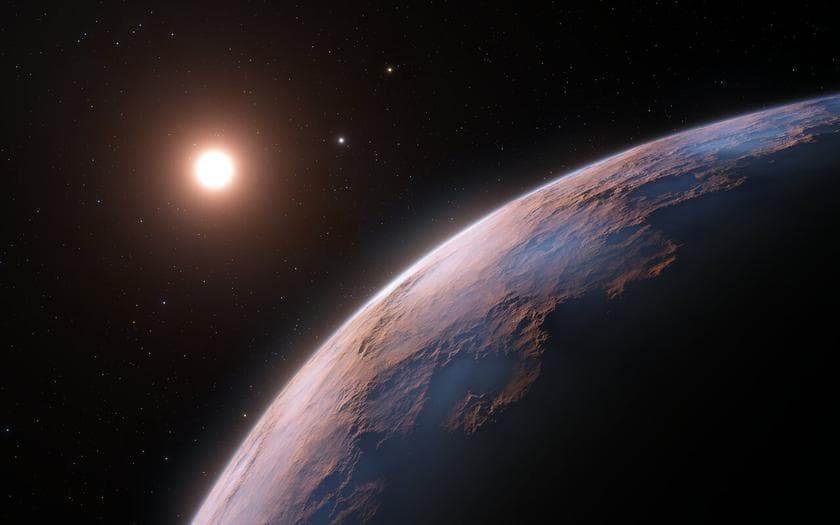
Artist’s conception of Proxima Centauri b
Table of contents
Open Table of contents
Intro
Less than 30 years ago, the existence of exoplanets was just a hypothesis and we were completely unaware of the existence of any planets outside our own solar system. Now more than 3,000 extrasolar planets have officially been listed since 1995, and at least another 2,400 need to be confirmed. Proxima Centauri b is our closest known exoplanet neighbor, at a distance of about 4.24 ly.
Characteristics
| Property | Value |
|---|---|
| Planet type | Super Earth |
| Discovery date | 24 August 2016 |
| Discovery site | European Southern Observatory |
| Mass | 1.07 Earths |
| Planet radius | 1.03 x Earth |
| Orbital radius | 0.04856 AU |
| Orbital period | 11.2 days |
| Eccentricity | 0.02 |
| Detection method | Radial Velocity/Doppler spectroscopy |
| Star | Proxima Centauri |
Discovery
Proxima Centauri b was discovered using the radial velocity method, also known as the Doppler method using the HARPS (High Accuracy Radial velocity Planet Searcher) spectrograph installed on the 3.6-metre telescope at the La Silla Observatory in Chile. The discovery of Proxima Centauri b was announced in August 2016, following years of careful observations and data analysis.
Host star
Proxima Centauri b orbits a small, faint, and relatively cool star known as Proxima Centauri, which is part of the Alpha Centauri star system. Proxima Centauri is a rather dim red dwarf star, with only 12.3% of the Sun’s mass, only 14.1% of its radius, and only 0.17% of its net energy output. As a consequence, its habitable zone must be rather close to the star. Like most small stars, Proxima Centauri is relatively unstable, and it is known to produce frequent large solar flares. Its corona temperature is relatively low, 3,042 K as compared to 5,772 K for our Sun. Most of its emitted light is in the infrared rather than the visible.
Habitability
Unfortunately for any life that may call that planet home, they’re going to have a rough time of it. Proxima Centauri is a red dwarf star, with only a fraction of the mass of the Sun. Because of their small sizes, the nuclear fusion cores of red dwarf stars are much closer to their surfaces. This makes their surfaces much more chaotic than stars like the Sun, and that increased turbulence amplifies incredibly strong magnetic fields. This would make it extremely difficult for the planet to host an atmosphere, let alone liquid water. While it doesn’t completely rule out the possibility of life on that world, it does mean that any life that gained a foothold there has a much harder time than us.
Exploration
Traveling to Proxima Centauri b using our current technology is not possible. Proxima Centauri b is located approximately 4.24 light-years away from Earth, which means that even if we could travel at the speed of light, it would still take us over 4 years to reach the planet.
Currently, our fastest spacecraft, the Parker Solar Probe, can only travel at a speed of around 430,000 miles per hour (690,000 kilometers per hour), which is about 0.06% of the speed of light. At this speed, it would take the spacecraft over 6,000 years to reach Proxima Centauri b.
However, there are ongoing efforts to develop new technologies that could potentially allow us to travel to other star systems more quickly, such as using advanced propulsion systems like nuclear or antimatter engines.
Among the proposed technologies to reach Proxima Centauri b in human lifespans are solar sails that could reach speeds of 20% the speed of light, problems would be how to decelerate a probe when it arrives in the Proxima Centauri system and collisions of the high-speed probes with interstellar particles. Among the projects of travelling to Proxima Centauri b are the Breakthrough Starshot project, which aims to develop instruments and power systems that can reach Proxima Centauri in the 21st century.
Outro
Overall, while Proxima Centauri b is an intriguing candidate for potentially habitable exoplanets, much is still unknown about its properties and conditions. Future research and observations will be needed to better understand the planet and determine its habitability. It would be very exciting that the nearest star to the Sun also hosts the nearest habitable or perhaps inhabited planet.